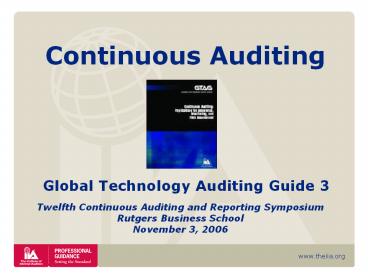Continuous Auditing - PowerPoint PPT Presentation
Title:
Continuous Auditing
Description:
Continuous Auditing Global Technology Auditing Guide 3 Twelfth Continuous Auditing and Reporting Symposium Rutgers Business School November 3, 2006 – PowerPoint PPT presentation
Number of Views:245
Avg rating:3.0/5.0
Title: Continuous Auditing
1
Continuous Auditing
- Global Technology Auditing Guide 3
Twelfth Continuous Auditing and Reporting
Symposium Rutgers Business School November 3, 2006
2
Institute of Internal Auditors
The Institute of Internal Auditors is a global
professional association with more than 122,000
members, and is recognized as the internal audit
professions leader in certification, education,
research and technical guidance. Its mission
includes
- Advocating and promoting the value that internal
audit professionals add to their organizations - Providing comprehensive professional educational
and development opportunities - Researching, disseminating, and promoting to
practitioners and stakeholders knowledge - Educating practitioners and other relevant
audiences on best practices in internal auditing
and - Bringing together internal auditors from all
countries to share information and experiences.
3
GTAG
Written primarily for the chief internal audit
executive (CAE) and audit supervisors, the guides
address concerns of the board of directors and
chief-level executives. Each Global Technology
Audit Guide (GTAG) is written in straightforward
business language to address timely issues
related to information technology management,
control, or security. GTAG is a ready resource
series for chief audit executives to use in the
education of members of the board and audit
committee, management, process owners, and others
regarding technology-associated risks and
recommended practices.
4
What This Guide Covers
- Role of continuous auditing in todays internal
audit environment - Relationship of continuous auditing, continuous
monitoring, and continuous assurance - The application and implementation of continuous
auditing - Benefits of a continuous, integrated approach
5
Role of Continuous Auditing
- Todays audit challenges
- Regulatory compliance controls
- Internal audit value and independence
- Availability of skilled resources
- Determining appropriate technology solutions
- Need for timely, ongoing assurance over risk
management and control systems - Role of continuous auditing
- Provides more frequent, more timely, analyses to
better manage control deficiencies and risk
6
Gaining Clarity Some Definitions
- Continuous Auditing
- Method used to perform audit-related activities
on a continuous basis includes control and risk
assessment - Performed by Internal Audit
- Continuous Monitoring
- Processes to ensure policies/processes are
operating effectively and to assess
adequacy/effectiveness of controls - Performed by operational/financial management
audit independently evaluates adequacy of
management activities - Continuous Assurance
- Combination of continuous auditing and audit
oversight of continuous monitoring
7
Relationship of Continuous Auditing/Monitoring/Ass
urance
- Role of continuous auditing dependent on
managements role in continuous monitoring of
controls - Inverse relationship the greater the role of
management, the less of a direct role of
internal audit
- True continuous assurance
- Depends on effective monitoring by management of
internal controls and Audits independent
assessment of that function
8
Application Areas
- Continuous control assessment
- Identification of control deficiencies
- Identification of fraud, waste, abuse
- Continuous risk assessment
- Examination of consistency of processes
- Development of enterprise audit plan
- Support to individual audits
- Follow-up on audit recommendations
9
Key Steps to Implementation
- Establish audit objectives and requirements
- Gain executive-level support
- Ascertain degree to which management is
performing monitoring role - Select appropriate technology solutions
- Identify information sources and gain access
- Understand business processes and identify key
controls and risks - Build audit skill set
- Manage and report results
10
Benefits
- Increased scope of audit activities
- Increased ability to mitigate risk
- Reduced cost of internal control assessment
- Increased confidence in financial results
- Improvements to financial operations
- Reduced financial errors and potential for fraud
- Reduced revenue leakage for improved bottom-line
results - Sustainable and cost-effective means to support
compliance































